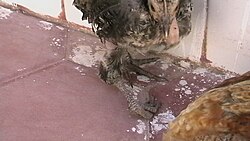Biology:Mardivirus
| Mardivirus | |
|---|---|

| |
| duck afflicted by Gallid alphaherpesvirus 2 | |
| Virus classification | |
| (unranked): | Virus |
| Realm: | Duplodnaviria |
| Kingdom: | Heunggongvirae |
| Phylum: | Peploviricota |
| Class: | Herviviricetes |
| Order: | Herpesvirales |
| Family: | Orthoherpesviridae |
| Subfamily: | Alphaherpesvirinae |
| Genus: | Mardivirus |
| Species | |
|
See text | |
| Synonyms[1] | |
| |
Mardivirus is a genus of viruses in the order Herpesvirales, in the family Herpesviridae, in the subfamily Alphaherpesvirinae. Chickens, turkeys, and quail serve as natural hosts. There are six species in this genus. Diseases associated with this genus include: Marek's disease, which causes asymmetric paralysis of one or more limbs, neurological symptoms, and development of multiple lymphomas that manifest as solid tumors.[2][3] Gallid herpesvirus 2 (also known as Marek's disease virus) is the only one of these viruses known to be pathogenic and due to the antigenic similarity between the three viruses the other two have been used to vaccinate against Marek's disease. These viruses have double stranded DNA genomes with no RNA intermediate.[4][5]
Species
The genus consists of the following six species:
- Anatid alphaherpesvirus 1
- Columbid alphaherpesvirus 1
- Gallid alphaherpesvirus 2
- Gallid alphaherpesvirus 3
- Meleagrid alphaherpesvirus 1
- Spheniscid alphaherpesvirus 1
Structure
Viruses in Mardivirus are enveloped, with icosahedral, spherical to pleomorphic, and round geometries, and T=16 symmetry. The diameter is around 120–200 nm. Genomes are linear and non-segmented, around 175kb in length.[2]
| Genus | Structure | Symmetry | Capsid | Genomic arrangement | Genomic segmentation |
|---|---|---|---|---|---|
| Mardivirus | Spherical pleomorphic | T=16 | Enveloped | Linear | Monopartite |
Life cycle
Viral replication is nuclear, and is lysogenic. Entry into the host cell is achieved by attachment of the viral gB, gC, gD and gH proteins to host receptors, which mediates endocytosis. Replication follows the dsDNA bidirectional replication model. DNA-templated transcription, with some alternative splicing mechanism is the method of transcription. The virus exits the host cell by nuclear egress, and budding. Chickens, turkeys, and quail serve as the natural host.[2]
| Genus | Host details | Tissue tropism | Entry details | Release details | Replication site | Assembly site | Transmission |
|---|---|---|---|---|---|---|---|
| Mardivirus | Chickens; turkeys; quail | None | Cell receptor endocytosis | Budding | Nucleus | Nucleus | Aerosol |
Replication
The stages of replication are similar to other viruses in Alphaherpesvirinae, but there are a few differences. After the virus has entered the cell the nucleocapsids make their way to a nuclear pore where the virus genome is released and translocates into the nucleus. The virus genome replicates and is packaged up within the nucleus, this new nucleocapsid then buds from the inner nuclear membrane and so gains its primary envelope. The nucleocapsid is now in the perinuclear space in the endoplasmic reticulum, from here the nucleocapsid buds from the outer nuclear membrane and by an unknown mechanism loses its primary envelope leaving the nucleocapsid naked in the cytoplasm. The nucleocapsids finally gain their secondary envelopes by budding into cytoplasmic vesicles within the cell.[4][5]
References
- ↑ "New Taxonomic proposals of the Herpesviridae Study Group" (in en). 2004. https://ictv.global/ictv/proposals/2002.V072-080.Herpesviridae.pdf. "Replace the temporary genus name ‘Marek’s disease-like viruses’ with the genus name Mardivirus. Constructed from the term ‘Marek’s disease’"
- ↑ 2.0 2.1 2.2 "Viral Zone". ExPASy. http://viralzone.expasy.org/all_by_species/522.html.
- ↑ "Virus Taxonomy: 2020 Release". International Committee on Taxonomy of Viruses (ICTV). March 2021. https://ictv.global/taxonomy.
- ↑ 4.0 4.1 "The protein encoded by the US3 orthologue of Marek's disease virus is required for efficient de-envelopment of perinuclear virions and involved in actin stress fiber breakdown". J Virol 79 (7): 3987–97. 2005. doi:10.1128/JVI.79.7.3987-3997.2005. PMID 15767401.
- ↑ 5.0 5.1 "High-level expression of Marek's disease virus glycoprotein C is detrimental to virus growth in vitro". J Virol 79 (10): 5889–99. 2005. doi:10.1128/JVI.79.10.5889-5899.2005. PMID 15857974.
External links
Wikidata ☰ Q1894465 entry
 |

